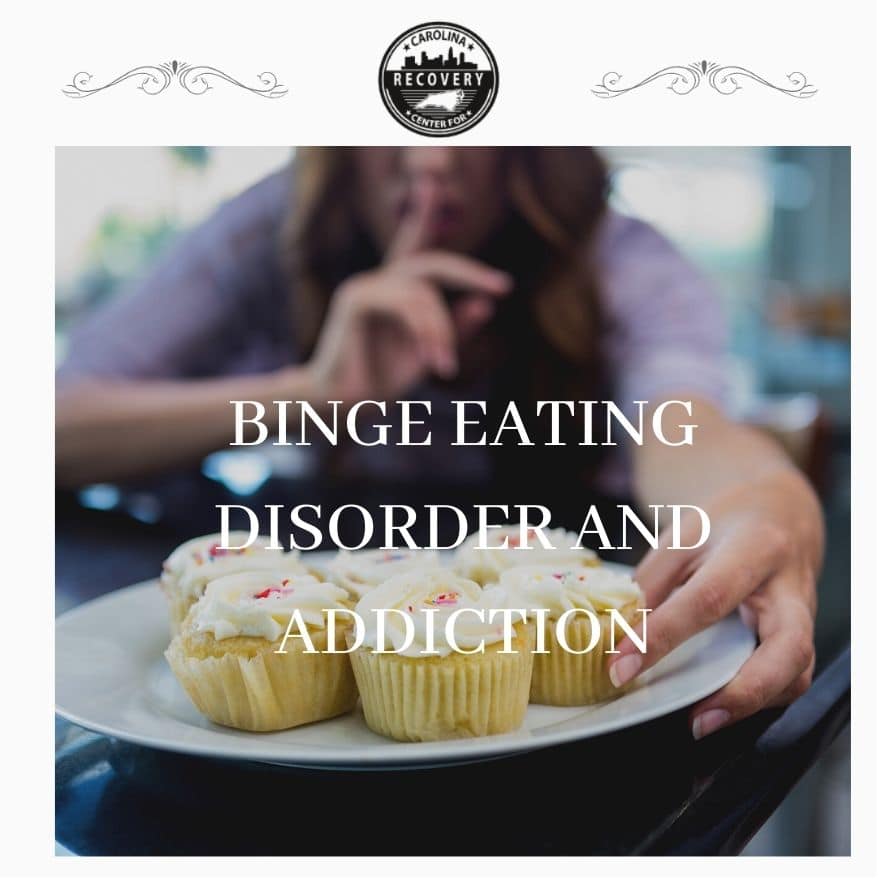Binge Eating Disorder and Addiction

Medically Verified: 2/1/24
Medical Reviewer
Chief Editor

All of the information on this page has been reviewed and verified by a certified addiction professional.
Food is often seen as a way to connect with others, indulge in pleasure, or fuel the body for optimal vitality. However, different people have different relationships with the food they consume. Some people use food as a means of coping with mental distress. One of the most common types of eating disorders is binge eating disorder.
Binge eating disorder is characterized by compulsive and uncontrollable overeating. It is usually done as a way to cope with unpleasant or difficult emotions. While everyone overeats on occasion, those who do this on a regular basis and have difficulty controlling how much or how often they eat are said to struggle with binge eating.
Unfortunately, many people who struggle with binge eating disorder (BED) also struggle with drug or alcohol addiction.
Signs and Symptoms of Binge Eating Disorder (BED)
Binge eating disorder is the most common eating disorder in the United States. Nearly 1.25% of women and 0.42% of men struggle with this condition.[1] Simply eating large amounts of food is not indicative of BED. People who struggle with this condition have symptoms that occur at least one time each week and have lasted for at least three months.
Signs and symptoms of BED include:[2]
- Regularly eating abnormally large amounts of food
- Frequent lack of control over what, how much, or how often food is eaten
- Eating faster than usual
- Eating until uncomfortably full or sick
- Regular feelings of low-self esteem
- Eating large quantities of food even though one isn’t hungry
- Frequent dieting and fad-dieting
- Eating alone to avoid judgment or embarrassment over the amount of food eaten
- Feeling guilty, depressed, or disgusted after binging
- Hiding food or wrappers to avoid being caught binge eating
According to the National Eating Disorders Association, BED is one of the newest eating disorders to be formally recognized in the Diagnostic and Statistical Manual of Mental Disorders (DSM-V).[2] It is diagnosed based on the following criteria:
- Recurrent episodes of binge eating with a lack of self-control over eating amounts of food that are larger than what others would consume in the same circumstances.
- Binges are associated with three of the following:
- Eating more rapidly than normal
- Eating until uncomfortably full
- Avoiding eating around others due to embarrassment
- Feeling guilty or disgusted after binging
- Having distress over one’s binge eating
- Binge eating, on average, at least once a week for three months
- Binge eating does not fall in line with bulimia nervosa or anorexia nervosa
The Relationship Between Binge Eating Disorder and Addiction
Binging on food causes a surge in dopamine in the brain. This temporarily reduces feelings of depression and anxiety. As a result, people who binge eat often do so to experience feelings of calm, safety, and comfort.
These feelings of relief are usually fleeting. Over time, binge eating stops being enough to numb the symptoms of underlying mental health issues. This is one reason why substance abuse is so common among people with BED. Substances can not only produce feelings of well-being, but they can also stimulate appetite and even increase a person’s interest in food–further increasing the chances of a binge eating episode.
Binge Eating Disorder and Alcohol Abuse
Food and alcohol are often consumed in the same setting. And, just like food, alcohol can promote feelings of comfort, well-being, and social connection. However, alcohol is also a depressant that alters judgment. People who already lack self-control may find themselves binging even more while under the influence without realizing how much they are eating.
At the same time, alcohol is full of empty calories. People who develop alcohol use disorder may even get most of their calories through alcohol and attempt to restrict food calories so they can keep drinking. This can lead to the development of a secondary eating disorder.
Binge Eating Disorder and Drug Abuse
While it’s true that binge eating disorder can exist alongside any type of drug addiction, stimulants and marijuana are the most commonly abused drugs among people with BED.
One common side effect of marijuana is increased hunger. As a result, marijuana abuse can lead to increased feelings of hunger and larger binges. Further, marijuana cravings are often associated with food that is high in calories and low in nutritional value, making binges even more damaging to one’s health.
Stimulants, on the other hand, reduce appetite. Some people with BED will abuse stimulants to help control their appetite and reduce the likelihood of a binge. Stimulants such as Adderall, cocaine, and methamphetamine are all highly addictive and detrimental to one’s physical and mental health. Regular stimulant use can worsen binges and increase symptoms of anxiety and depression.
How Substance Abuse and Addiction Affect Binge Eating
BED and addiction share many addictive characteristics. Both binge eating and substance abuse provide temporary feelings of relief that are followed by feelings of guilt, remorse, shame, and anxiety. Similarly, binge eating disorder and addiction are both characterized by urges, binges, and cravings.[3]
In order to overcome BED, treatment must address a person’s relationship with food and their underlying feelings of depression and anxiety. However, substance abuse can change the way the brain works. Drug and alcohol abuse can make it difficult for people with BED to feel their emotions and become aware of their feelings.
Co-occurring BED and addiction can result in a variety of life-threatening medical complications, such as high blood pressure, gastrointestinal problems, diabetes, obesity, fatty liver disease, and cardiovascular disease. In the short-term, affected individuals may experience extreme changes in their weight or difficulty losing weight.
The National Eating Disorders Association estimates that up to 50% of individuals with eating disorders have abused alcohol or drugs in their lifetime, a rate that is five times higher than the general population. Up to 35% of these individuals were considered to have a substance use disorder.[4]
Find Treatment for Eating Disorders and Addiction
Eating disorders and addiction are treated using individual therapy, group counseling, peer support groups, and nutritional counseling. This comprehensive approach addresses the underlying causes of BED and addiction while also teaching patients how to live a healthier lifestyle.
Here at Carolina Center for Recovery, our dual diagnosis treatment program can help address eating disorders and substance abuse issues. If you or a loved one are struggling with addiction and eating disorders, give us a call today.
References:
- https://www.niddk.nih.gov/health-information/weight-management/binge-eating-disorder/definition-facts
- https://www.nationaleatingdisorders.org/learn/by-eating-disorder/bed
- https://www.ncbi.nlm.nih.gov/pmc/articles/PMC3671377/
- https://www.nationaleatingdisorders.org/substance-abuse-and-eating-disorders

